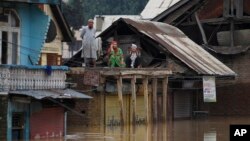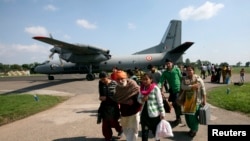As flood-ravaged Indian Kashmir faces a communication blackout, social media posts on Facebook and Twitter are playing a huge role in tracing people stranded in the region.
More than 400 people in India and Pakistan have been killed in the floods which have engulfed the mountainous region, and tens of thousands are waiting to be rescued.
Aijaz Qaisar, who works in Bangalore, is desperate for news of his ailing, elderly parents and his brother’s family. They had to scramble to the third floor of their home in Kashmir’s summer capital, Srinagar, after floodwaters inundated the lower two floors.
“It’s a kind of attic, they are in an attic. It was again through Facebook, my brother, youngest brother, he had posted pictures of water all around…and after that no communication at all," he said. "[I am] completely, completely helpless.”
Qaisar has posted an SOS plea on Facebook, “please rescue Mr. Qaisar-ud-Din’s family” and given their address. Until Wednesday afternoon, he was still waiting.
“I am hoping, I am hoping that somebody would respond," he said. "I am hoping one call back telling me that water has not gone beyond, and there is food being supplied or at least water being supplied.”
Like Qaisar, tens of thousands of distressed relatives have flooded Facebook and Twitter with cries for help, urging rescuers and army personnel working in Indian Kashmir to reach their loved ones.
With phone and power lines down, those stranded are unable to call for help. And so such posts are helping to point rescue teams in the right direction. At the moment rescuers have virtually no way of identifying victims most urgently in need of help - the sick, the elderly and children.
While Qaisar has not yet been lucky, many others have. A Facebook exchange between the army and the sister of a woman, who is nine months pregnant, shows that soldiers responded to her plea on social media and rescued the stranded woman.
Army officials say all messages for help being received on its website are being forwarded to a group that includes senior commanders in the region. Starting Monday, the army also began putting up a list of rescued people on one of its Facebook accounts to keep relatives informed.
Self-help groups have also sprung up on Facebook sharing information on missing people. Google has allied with the National Disaster Response Force to create a database of stranded and missing people. People wanting to donate are connecting on the hashtag #Kashmirfloods.
Sunil Abraham at the Center of Internet and Society says social media can be a powerful tool for collaboration in situations like the ones faced by Kashmir.
“Through features like hashtag, you can form dynamic, express community,' he said. "Here social media has a marked advantage because an express platform for collaboration can be set up instantaneously.”
About 50,000 people have been rescued so far - 40,000 of them by the armed forces. But tens of thousands are still trapped in their homes.
The army, posted in huge numbers in the Himalayan region that borders Pakistan, is at the forefront of the massive rescue effort.
Atul Bhatia, an army official in Jammu region who turned a generator on an army truck into a mobile recharge point, told an Indian television channel that lack of communication is the biggest problem.
“The connect with relatives of theirs outside this area was the most important thing for the relatives and them to be assured that everything is fine," he said.
"With no electricity for five days out here, it was important their mobiles start working.”
The floods engulfed the region a week ago, devastating villages and towns, and destroying roads and bridges in the scenic mountain region.










